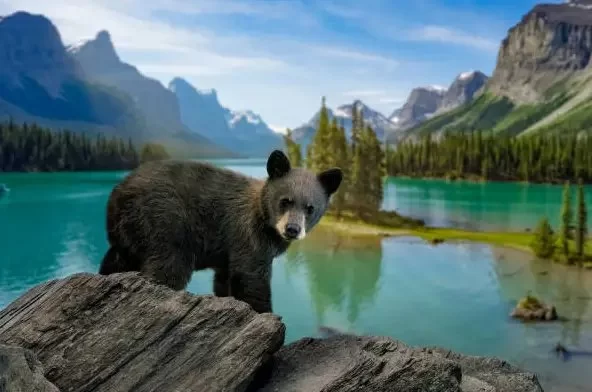Best Practices for Wildlife Viewing Responsibly
- 1. Why Wildlife Viewing Matters
- 2. Respecting Wildlife and Their Habitat
- 3. Ethical Guidelines for Responsible Wildlife Viewing
- 4. Real-Life Examples of Responsible Wildlife Viewing
- 5. Benefits of Responsible Wildlife Viewing
1. Why Wildlife Viewing Matters
Wildlife viewing is a rewarding experience that allows us to connect with nature and appreciate the beauty of the animal kingdom. However, as we venture into natural habitats, it's crucial to be aware of the impact our presence can have on these delicate ecosystems. Whether you're watching animals in their natural environment or visiting a wildlife reserve, the responsibility of doing so ethically is vital for both the wildlife and the environment.
The Role of Wildlife Viewing in Conservation:
Wildlife viewing, when done responsibly, can contribute to conservation efforts. It helps raise awareness about endangered species and the importance of preserving their natural habitats. Additionally, ethical wildlife tourism often generates funds that can be used to protect wildlife and maintain ecosystems.
2. Respecting Wildlife and Their Habitat
When viewing wildlife, it's essential to respect the animals and their environment. This means minimizing disturbances to their natural behaviors, keeping a safe distance, and avoiding actions that could stress or harm them. Respecting wildlife involves understanding that animals are not there for our entertainment, and they deserve the same level of respect as any other living being.
1. Keeping a Safe Distance
One of the most critical aspects of responsible wildlife viewing is maintaining a safe distance from animals. Approaching too closely can cause stress, disrupt their natural behaviors, or even provoke aggressive responses. It’s essential to observe animals from a distance that allows them to feel safe and unthreatened.
2. Not Feeding Wildlife
Feeding animals can have detrimental effects on their health and behavior. It can lead to dependency on humans for food, disrupt their natural diet, and even encourage aggressive behavior. Moreover, certain foods that humans consume can be harmful to animals. Never feed wildlife and avoid offering them food or treats.
3. Avoiding Habitat Disturbance
It's important to be mindful of the environment you’re entering. Avoid stepping on fragile plants, disturbing nests, or altering the landscape. Animals rely on these environments for shelter, food, and safety. Every small action can have a significant impact on their well-being and habitat.
3. Ethical Guidelines for Responsible Wildlife Viewing
To ensure that wildlife viewing remains sustainable and does not harm the animals or their environment, it's essential to follow ethical guidelines. These principles not only protect the animals but also enhance the experience for all involved.
1. Choose Ethical Wildlife Tour Operators
Before embarking on a wildlife viewing adventure, research tour operators that follow ethical practices. Responsible operators prioritize animal welfare, ensure minimal environmental impact, and support conservation efforts. Check reviews, certifications, and their commitment to wildlife protection.
2. Follow Local Regulations and Guidelines
Every wildlife sanctuary or reserve has specific regulations designed to protect the animals and their habitats. These might include speed limits for vehicles, restrictions on when and where you can access certain areas, or guidelines for interacting with the animals. Always adhere to these rules to ensure your actions are responsible and safe.
3. Avoid Nocturnal Disturbance
Many animals are nocturnal and are more sensitive to human disturbance during their rest hours. If you're participating in night safaris or other after-dark wildlife activities, be sure to keep noise levels low and use red light flashlights, which are less intrusive to animals' eyes.
4. Real-Life Examples of Responsible Wildlife Viewing
Understanding how responsible wildlife viewing plays out in real-life situations can help illustrate the impact of following ethical practices. Here are some examples that show how awareness and responsibility contribute to the well-being of both the wildlife and the viewing experience.
1. The Success of Eco-Tourism in Africa
In Africa, eco-tourism has become a powerful tool for wildlife conservation. Safari operators in Kenya and Tanzania, for example, have implemented strict ethical guidelines that allow visitors to view wildlife while minimizing human impact. Funds from these safaris help support conservation programs and protect endangered species like elephants and rhinos.
2. Protecting Marine Life through Responsible Whale Watching
Whale watching is a popular activity in coastal regions around the world. However, responsible whale watching practices are crucial to ensure that boats do not disturb the whales' natural migration patterns. In places like Alaska and Iceland, operators use guidelines to maintain a safe distance from the whales, ensuring the animals' safety while providing a thrilling experience for visitors.
5. Benefits of Responsible Wildlife Viewing
Adopting responsible wildlife viewing practices benefits not just the animals, but also the travelers and the broader ecosystem. Here are some of the advantages of viewing wildlife ethically:
1. Promotes Conservation Efforts
When wildlife viewing is done responsibly, it helps fund conservation initiatives and ensures that more habitats are protected. Tourists who engage in ethical wildlife viewing practices contribute directly to preserving endangered species and natural environments.
2. Enhances the Experience
By respecting animals and their environment, travelers enjoy a more fulfilling and authentic experience. Watching animals behave naturally, without the stress of human interference, offers a deeper connection with nature and a more enriching adventure.
3. Supports Sustainable Tourism
Ethical wildlife viewing promotes sustainable tourism, which benefits local communities and economies. Responsible practices ensure that tourism does not degrade the environment, but rather supports long-term conservation efforts and local livelihoods.







